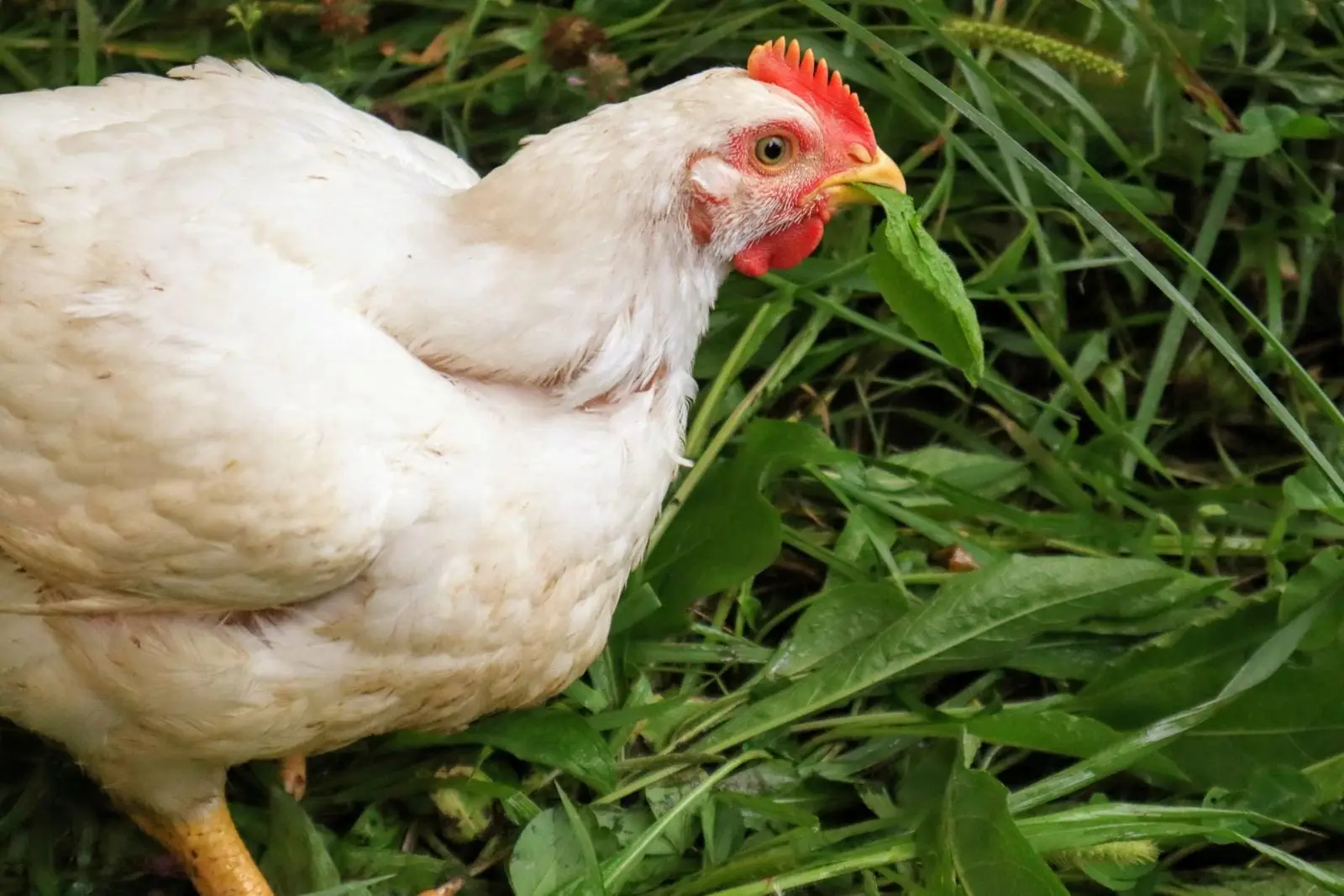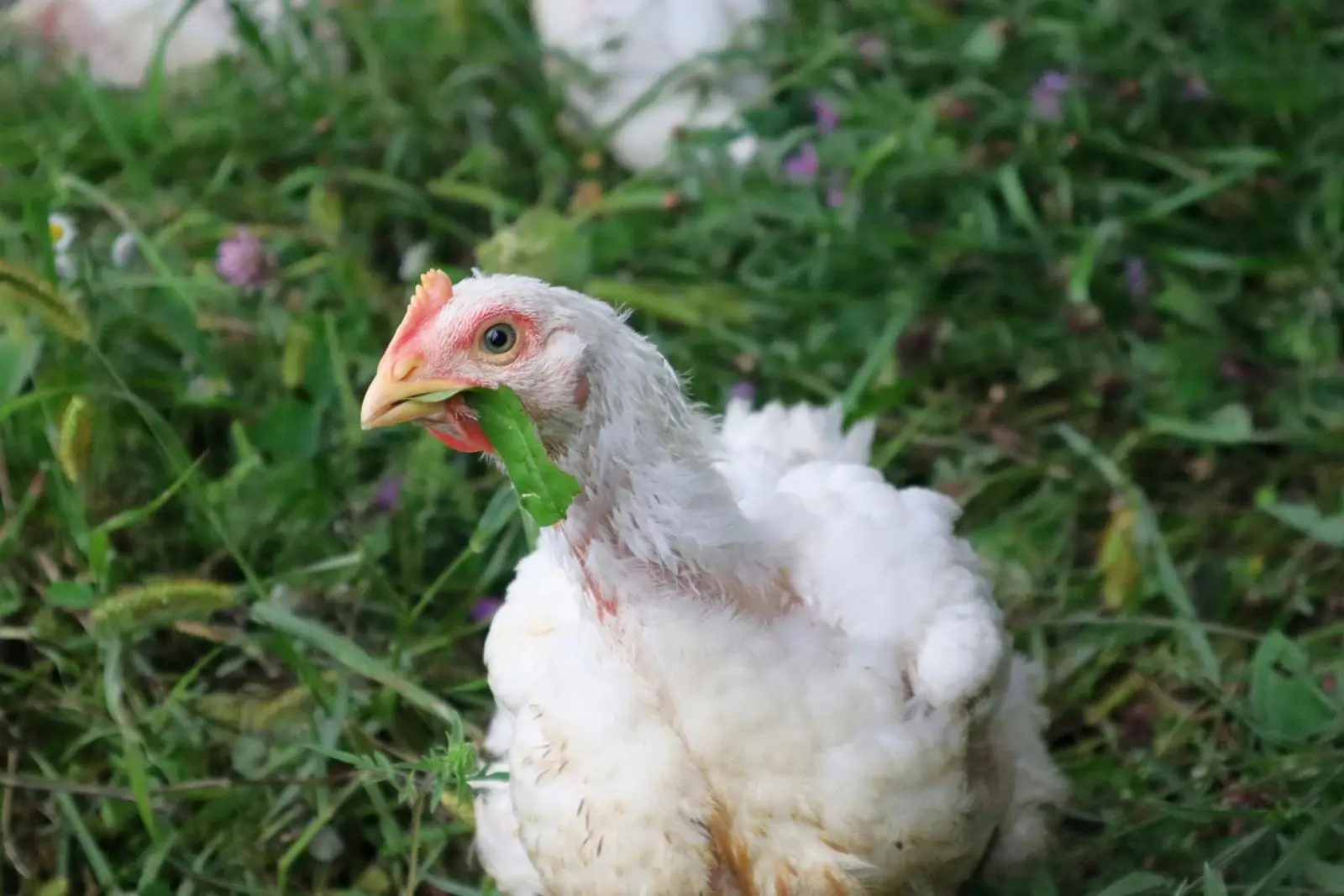Let’s talk about grass fed chicken. As people learn about healthier meats, the term “grass fed” often is one of the first big concepts they encounter. And rightly so, because grass fed meats can be some of the most nutritious food available. The flavors are outstanding compared to bland, conventional meat. Grass fed meats are produced in a manner that improves grazing ecosystems and landscapes. There’s a whole world of fascinating stuff to discover and to love about grass fed meat.
Here’s the catch… Americans eat more chicken than any other meat, so when they go looking for grass fed meat, they often start the search looking for grass fed chicken. I can see this in my farm’s web traffic statistics when I look at the search terms. People are looking online for grass fed chicken. But there is no such thing as grass fed chicken.
But Chickens Do Eat Grass, Right?
No grass fed chicken you say? Wait a minute, the Wrong Direction Farm website is full of pictures of chickens eating grass and other plants. Like this one:

So, yes, it is true that chickens eat grass. Our chickens eat grass every day. We believe it is essential to chicken health and we wouldn’t raise chickens if they couldn’t eat grass. But there still are no grass fed chickens.
What Does Grass Fed Mean?
Let’s talk about definitions. Grass fed means that an animal only eats grass. Thus you could have grass fed beef from cattle that only grazed grasses. Or grass fed lamb, goat, or bison. Even grass fed deer, moose, elk, water buffalo, gazelle, yak, or antelope. These animals all have one thing in common: they are a classification of herbivore (plant eater) called a ruminant.
Let’s look at beef, since that is probably more familiar to most of us than lamb, goat, or bison. Grass fed beef comes from farms farms where the cattle only graze the grasses and leafy plants growing in their pastures.
Grass fed beef makes intuitive sense, but it isn’t the way most beef cattle are fed in the United States. Rather than raise cattle on grass, after the cattle are 9 to 12 months old, most conventional beef feeding operations move the cattle to feedlots for concentrated grain feeding. These diets are usually corn-based, although they can include other grains or grain byproducts depending on the availability of local supply. Grains provide extra carbohydrates that grow the cattle faster, but this growth comes at the cost of cattle health. And then there are the conditions of the feedlot and the problems of concentrated manure runoff and other unpleasantness. So it becomes clear quickly that there is a strong case for the superiority of feeding cattle their natural grass diet instead of a grain diet.
Side note: There are unscrupulous meat vendors selling meat as “grass-fed, grain-finished”. So we often need to be very specific and state that true grass fed meat is grass fed and grass finished (ie, the cattle never ate grain as part of a finishing ration). But I still prefer the correct usage of the term grass fed, and for the purpose of this article I’ll stick with the phrase grass fed instead of tacking on “and grass finished” every time.
Why Aren’t Chickens Grass Fed?
So why can’t chickens also be grass fed? The answer is in their anatomy.
Consider a cow. I mentioned before that cattle are classified as ruminants. This refers to the fascinating stomach arrangement these animals have. Ruminants have multiple compartments within their larger stomach complex. The first and largest is the rumen. As cattle graze plants, they ingest large quantities of relatively low energy forage. Imaging the challenge of trying to get your daily 2000 calories by eating lettuce, but this is what a cow does. After ingesting a pile of plant leaves, the material sits in the rumen where beneficial bacteria ferment it. The bacteria do the hard work of extracting useful sugars, proteins, and fats from the forage. After fermentation, the rest of the cow’s digestive system extracts the necessary nutrients.
Now consider a chicken. First note that a chicken is a much smaller animal, so it cannot physically hold the large quantities of grass in a fermentation arrangement. It has a shorter digestive tract, so the chicken needs to quickly and efficiently process foods. When chickens eat, their food first passes into a highly acidic stomach. The stomach muscles bathe the food in acid and massage it before passing into the next organ, the gizzard. Gizzards grind food into smaller bits with the help of rocks the birds eat and accumulate within this heavily-muscled organ. The grinding action of the rocks easily crushes seed hulls, insect exoskeletons, and other tough foods. After pulverization in the gizzard, food exits into the intestine for final nutrient extraction.
Chickens are naturally omnivores. They eat grasses and leaves, but they prefer the higher nutrient density of seeds, nuts, and fruit. And they love insects and worms. Their digestive system, with the combination of a preliminary acid bath followed by a pulverizing operation allows them to thrive on a more varied diet. Eating grasses alone would leave the chickens short on their daily requirements for both digestible energy and protein. Chickens aren’t cows, and we must not treat them the same way.
Why Do Chickens Eat Grass?
So if chickens aren’t strictly herbivores, why do they eat any grass? And if they aren’t grass fed,why do I make such a big deal about Wrong Direction Farm’s chickens being out on grass?
I should start by stating that the chicken industry doesn’t have much appreciation for grass, which is obvious since they keep their birds in barns without any grass. Even supposedly free range chickens often don’t have grass. So while many aspects of chicken health have been studied exhaustively, there isn’t a huge body of research on the value of green plant material in a chicken diet.
Poultry science used to classify dietary fiber as “antinutritional”, basically unhelpful filler. More recent study has demonstrated that fiber stimulates gastrointestinal development, increases the number and diversity of bacterial species within the chicken’s microbiome, and promotes nutritional update during digestion. I am confident that as this topic is investigated further, the science will back up what chicken farmers have observed all along: green plants are essential to healthy chickens.
Without doing scientific study we can easily observe that chickens raised on grass have less stinky manure and that they have better formed gizzards than barn-raised chickens. The grass diet obviously results in physiological changes for the chickens.
Every day when I scoot their pasture shelter to a fresh patch of tender plants, our chickens charge ahead, racing each other to take the first bites of fresh clover, orchardgrass, burdock, and all the other green leaves on offering. Just look at this guy, greedily trying to swallow down a large leaf he’s picked from our pasture:

So it is obvious from the chickens’ behavior that they feel an instinctive need to eat green plants. By itself, that really should be all the justification we need to ensure that chickens have access to fresh greens. As a guiding principle I like to study the natural instincts and native environment of the animals when considering how they should be fed and raised.
Providing a Balanced Diet for Chickens
In the quest to provide a balanced diet for our chickens, we provide them with three main food groups that mimic their natural ancestral diet.
- We raise them on grass pastures to give them plenty of green plants to graze.
- We give them room in the field to forage for insects, grubs, and worms.
- We feed them 100% certified organic grain for the seed portion of their diet.
If were raising a small number of chickens, perhaps two or three per acre we wouldn’t need to give them any grain. They would be able to forage enough seeds on their own. But of course, a farm that only raised two or three chickens per acre would have to sell those chickens for a LOT of money just to cover property taxes and basic overheads. So there is always a certain productivity threshold required to make a living wage farming, and in this case we use use Certified Organic chicken feed to provide those calories.
We mentioned before that cattle can be harmed by grain feeding. It upsets the pH of their rumens, triggering a series of health issues. Chickens however can eat grain without ill effect. They naturally thrive on the starches in plant seeds. So everything is about context: for cattle grass fed means everything and grain fed is a problem, but for chickens grass is important while grain is also beneficial.
I’ve emphasized that our grain is Certified Organic several times now. I know farmers who raise chickens on pasture and feed their birds conventionally sprayed, GMO grains. Other farmers feed their chickens non-GMO grains sprayed with pesticides and herbicides. For our part, we’ve decided that the best food for our chickens is Certified Organic from a trusted local supplier we know. Feeding Certified Organic guarantees that our chickens are never exposed to pesticides or herbicides, and that all their feed is non-GMO. This feed is much more expensive, but we wouldn’t want to feed our chickens anything else.
Choosing Pasture Raised Chicken
In the end, you won’t find a grass fed chicken, but you can find a pasture raised chicken. Pasture raised is the gold standard for chicken. Because the birds are raised on pasture they are more vigorous and healthy. Better chickens produce more flavorful meat. Sure, pasture raising chickens adds layers of complexity to farming, but we welcome that challenge.
If you got here looking for grass fed chicken, don’t worry about the terminology. Lots of people get confused. But now that you know what to ask for, it’s time to try some pasture raised chicken. This is the chicken you’ve been looking for.

Learn More
If you’d like to read more about pasture raised chicken, here are some other resources we’ve written:
- All About Pasture Raised Chicken
- What We Know About Pasture Raised Chicken and Nutrition
- Pasture Raised versus Free Range
- Pasture Raised Makes A Difference
- What’s the Deal with “Vegetarian Fed” Chickens?
If you’d like to place an order, we be happy to deliver some to you. We keep a full selection of cuts in stock and we’d love to put some great chicken and turkey on your table. Learn more about our delivery and environmentally friendly packaging.

2 thoughts on “How to Find Grass Fed Chicken”
Hi! Does the organic grain you feed your chickens contain maggot meal?
No, the chicken feed doesn’t contain any insects. The chickens find their own bugs.
I’ve encountered people trying to scale up various insect or larval feed sources for poultry, but nobody is doing it at an economically viable scale for bulk feeding.